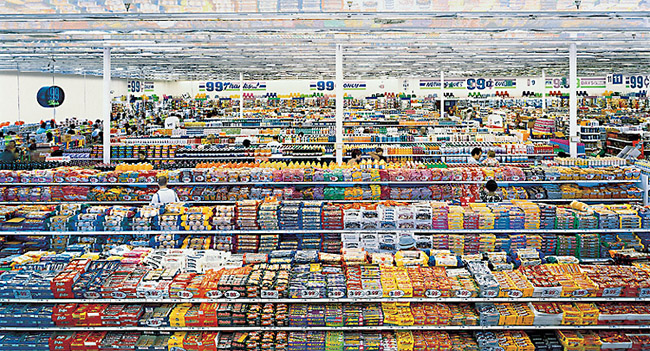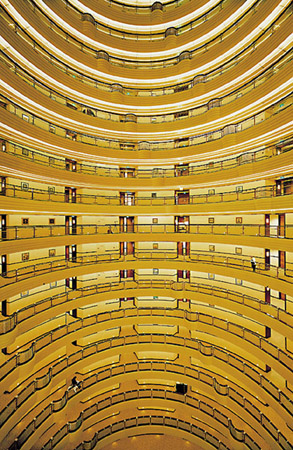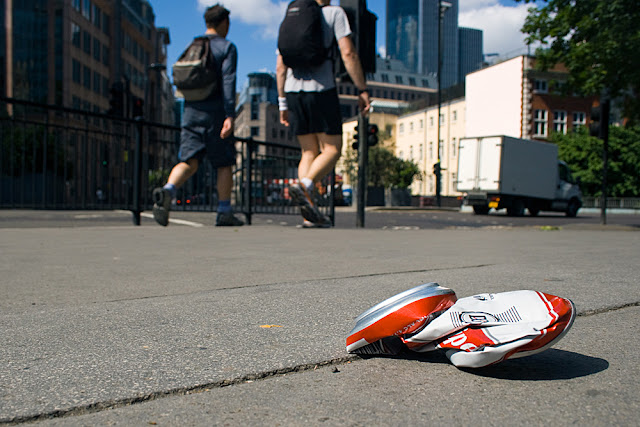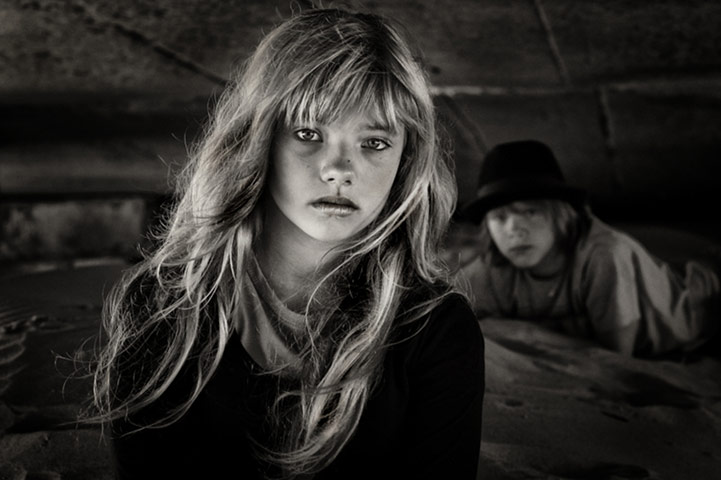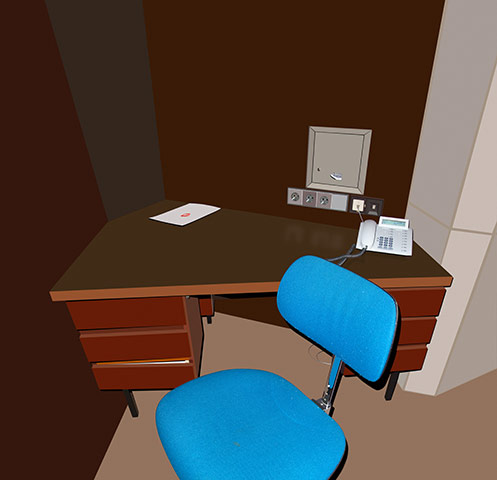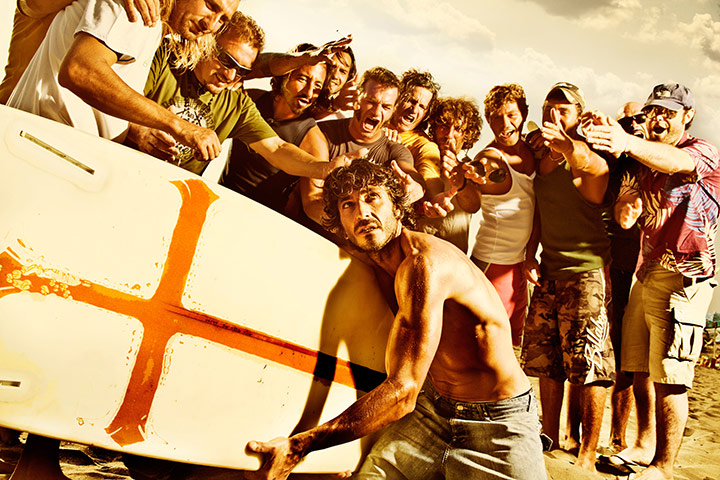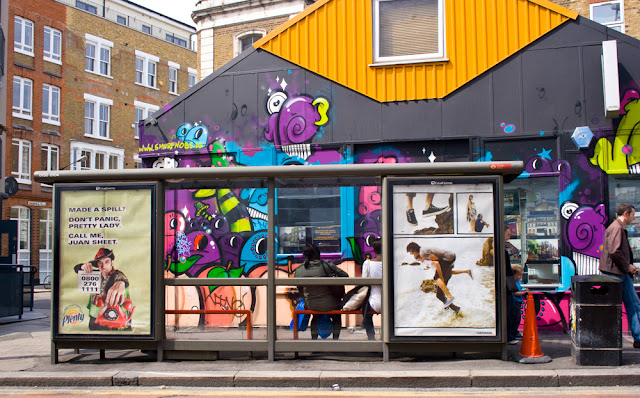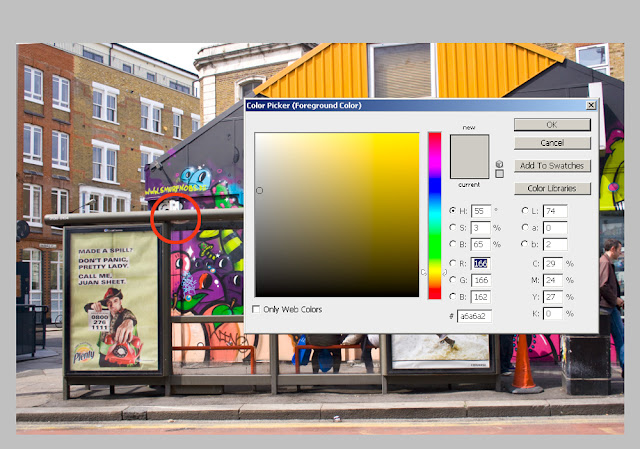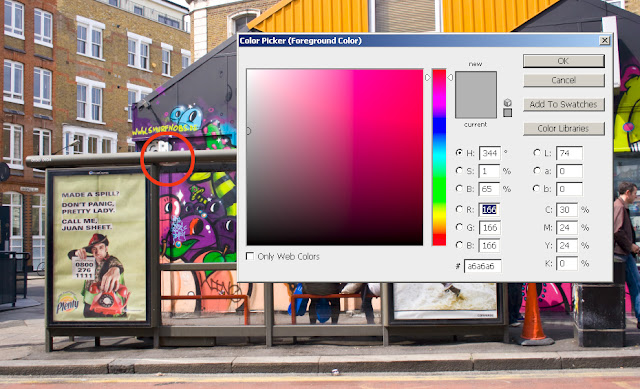OCA study day and my second. It was really great to meet up with people, ones I had seen before, some new and Gareth as the official "face" of the OCA. There is so much to write up about this day, hopefully I can put things down in an orderly fashion.
Starting with the beginning and the end of the day rolled together; my reasons for going. A question I put to myself when adding my name to the list then posed by Gareth at the end of the day. The reasons were many-fold: to meet fellow students, to talk to whoever it is on the day representing the OCA, a day trip out ;o), taking in an exhibition, learning whatever there is to be learnt from said exhibition and the main one to have an overview of the works of Paul Graham.
I know I have failings and one of them is being overly cynical and a tendency to not be as open minded as I should be. In order to overcome this I throw down the gauntlet to myself and say "you WILL give it a chance", this sadly included Paul Graham. My only experience of him had been a viewing, back in 2009, of his series "A Shimmer of Possibility" and seeing his interview on WeAreOCA hmmmmmmm "Monkey's Wedding" ....whilst agreeing with Gareth that his take on good art is a great definition “it’s about many things, it’s not just about one idea or one concept – it’s open, it’s about many different things and it’s often about more than the artist intended” I do think he occasionally oversteps the mark with his artistic statements, originally taking a shot (one I nicknamed LawnMower Man) because he was interested in the man and his US flag T shirt more than the landscape, he hears a noise, grabs his camera and starts shooting, he then reads more into it about Greek mythology, and the beauty of life, is it about racism, about the flow of life...? Thats what he reads into it after...that wasn't his initial intention. That is what annoys me sometimes about curators telling us what the intentions were...you know occasionally there isn't one, but we can all make one fit after the event. Anyway that was where I was coming from, I had decided I didn't much take a fancy to his work but based solely on one series...
Then this "retrospective" exhibition was advertised, or as working artists like to say "a mid-career survey" so in the spirit of being open-minded and willing to learn I signed up.
The exhibition itself covers bodies of work from 1981-2006 and show how Paul Graham has changed his style, subject matter and prefers to not re-visit what he has already done. Paul Graham prints all his own work and it was interesting to discover that apart from the A1 series, which are vintage prints, everything else was reprinted for this retrospective tour. It is divided into 3 sections, the earliest covering the British colour work, the second concerning itself with his travels, and the third ending up with the images he likes to think explores how the medium of photography can be used more than images with a political commentary.Unlike the exhibition, which starts with
Television Portraits, I'm going to discuss each series chronologically.
A1: The Great West Road
I liked this series, probably due to the fact I could identify with it and on so many levels. It didn't matter to me that it was of historical importance, being controversially one of the first significant works produced in colour in the UK. I could see the influences of other artists in particular William Eggleston and Stephen Shore (makes me smile when I can reference other's work and not just say it because it was something I saw on a website) It charts a road trip along the A1 during 1981-82. I enjoyed spotting things from my own cultural background, Little Chefs, people in aprons, smoking in places where it would now be banned, the fashions of the day, the style of the cars, the areas I have driven through and noting how they have altered. I think looking at his work retrospectively you can start to see his preference for bold vivid colours, red and blues seem prominent in a lot of his work. All these images were taken with a large format camera, are printed in the same style, size, relatively small 8x10, and the minute details don't seem to have as much significance as the main subject. I can see why this was considered as his breakthrough into photography and is held in such regard.
Beyond Caring
With images taken in 1984-1985 this was another series I could heavily identify with. Although never having been unemployed or having faced a "dole queue" I started work in 1980 and remember only too well the economic state at that time. The charts were full of protest songs, riots had occurred across the nation a few years back, and by 1984 unemployment was still rising... These photographs bring it all back, not sure if people from other "eras" or cultures would get the point as much, but that is one of the joys of photography, it can mean different things to different people. The images are printed on a larger scale, but still the same size, the angles are off due to the surreptitious nature of the capture, but I think this only adds to the uncomfortable surroundings, and the way that people must have felt out of kilter with the world.
Small details creep in, again spotting people smoking in an office, the discarded litter on the floor, maybe intentionally echoing the way the unemployed felt discarded (or am I doing my own version of let's make it up :oP) toddlers and babies buggies add to the throng showing women were affected as much as men, the adults and children alike holding their chins in their hands with bland emotionless expressions. Two images stand out in my mind especially, the one with the toddler in pink, a subtle contrast against the drab blues of the waiting men, the repeat pattern of walking sticks and me making up my own stories once more, is the toddler wondering "is this MY future?" That could have crossed Graham's mind or it could be he just pushed the button... and the other which made me smile was the image of a man reading a newspaper while the Victorian gentleman of the wall decoration seemed to peer over his shoulder doing the same. All in all quite depressing, you can't fail to read the message, feel the despondency, the images have a definite political overtone and tell the story of overcrowded unemployment offices of the period.
Troubled Land
Taken in 1985-86 this set crosses two genres, that of landscape and reportage.Yet another series I appreciated and identified with. Working in London I faced the disruption of bomb scares, and problems when actual incidents took place. Even though it had happened 10 years early, the assassination of Ross McWhirter by PIRA in 1975 had shocked me as a child (although McWhirter did have some ideas that I don't agree with) as had the murder of Lord Mountbatten. The "troubles" were something that were always there even if I didn't quite understand the history behind it then.
These images show quite a shift in Graham's work. They are printed in a large format and need to be for the smaller details to be fully visible and the context of hidden clues within the photograph to be seen. On the face of it each image is an impressive landscape shot, be it of sweeping fields or sprawling towns, however the closer you look the more you see; the painted kerb stones, the political flags and posters, the Union Flag in a tree and you realise you are looking at a landscape where every corner has an allegiance; it mattered, and it was dangerous. The photograph of the soldiers running across the roundabout was the most interesting to me for a few reasons. It appeared to be an everyday place, but apparently five minutes down the road in the direction the soldiers were running is the Falls Road. A name which was mentioned all the time on the news, it appears an everyday scene but then you notice it IS soldiers running, something you don't see everyday where I live. More political posters, graffiti on walls and railings saying "IRA", "PIRA", "SMASH THE H BLOCK" I dare say my daughter wouldn't even know what the H block was... how times change.
The main interest I had in this image was what I had been told about it. A friend of mine is a professional photographer sponsored by Sony, he attended the press opening of this exhibition and was lucky enough to speak to Graham about his images and ways of working. Apparently this image had been his "hook" his "way into" this set. Graham had been taking photographs of Ireland for a while but was not satisfied as most of what he was taking just resembled everyone else's; all armoured cars rumbling through streets etc. Then he took the roundabout shot, he realised he could expand the idea, look into that which was hidden. From then on his images were wide sweeping landscapes of Ireland with subtle clues, the helicopter in the sky, paint on the road from making banners, the "Republican Parade"...although there is now a question mark in my mind about this image. Labelled as "Republican Parade" it was pointed out to me that the flag on the flag pole was the Loyalist Banner, with another on a nearby chimney, and the bollards in the street were painted red, white and blue...so a Republican Parade happening there is fairly dubious...surprised no-one has pointed that out before....Subsequently this idea of hidden meanings does seem to appear in quite a few of his later bodies of work.
Again I can see why this body of work was considered to be exception at the time. Graham likes to publish his works in books making photography democratic, but with some images size does matter. There are many debates on the OCA forums about image size and how they should be presented and I think that seeing this exhibition has shown that what appears to be a trite reply of "it depends on your image" really is a truism.
Ok, so I'll not be strictly chronological but because it covers the same country...
Ceasefire
Series shot in 1994 hmmmmmmmmm yes this is where a hmmmmm comes in. Clouds.....large squares of dark clouds. I mused a cloud by any other name will rain as wet ;o) We are informed that these images, taken during a tentative halt in the troubles, were of the skies over flash points in Bogside,Newry,Omagh and Shankill... and a back story is you have to "trust" that this is what they are of and trust forms part of a ceasefire. That taken, I think more than anything they show if you have made a name in photography you can shoot anything and it will get hung in a gallery.... Reading the images "my way" and writing my own theories it could be that the land is fought over, but the air is free and everyone has a right to it, and can see it, what ever side of the fence they are on, also that the ceasefire was in effect but dark skies could still be ahead.....or it could even be that the weather so bad nothing else was working, in frustration Graham snapped at the sky and then thought.......ohhhhhhhhhhhhhhhh I could...........
New Europe
For me
New Europe,1988-1996, jumped about too much, there wasn't much coherence? But that could be due to the fact we were only given snapshots from the series.Strong reds and blues shone out but we had spit on Franco's grave, a one armed man in a gay cruising area, commercial looking "heroine chic" seedy portraits of drug users and prostitutes... I couldn't really identify with them so maybe that's why I couldn't empathise with the characters or understand the message? Short and to the point, shall we move on? I did...
Empty Heaven
Graham then turned his attention to Japan,1989-1995, and according to the "blurb" ideas of denial and concealment. I hadn't read any of the artist statements or the press release prior to viewing this work and I'm glad, as it meant that my initial gut reactions were honest with no pre-conceived ideas of what I was supposed to be reading into the photographs. This series left me cold. Graham also was exploring the idea of diptych and triptych presentation, but this still didn't explain to me why he had hung some images together. I couldn't see how certain images were supposed to gel. I could see why and how they were representative of Japanese culture, the young girl with Geisha like make up, her hand gesture of covering her mouth, the sweet wrapper with manga like drawings that always have huge western eyes, the symbolism of the Hiroshima bomb, the wrapped tree...I have tried but can't find out anywhere why they wrap trees but it does echo the constraints of Japanese traditions and how people are bound to them still, and it really reminded me of Araki and his bondage shots...I fear this series had me being very irreverent and joking that the kitten calendar wasn't taken in Japan at all, but in his kitchen back home in Margate (or Skeggie) and the portrait of the man stopped where it did because in reality from the neck down he was naked and bound......I may not have appreciated this series but it was a talking point and entertained us, which one could argue is the point of good photography and once an artist lets his creation out into the world he no longer controls how people view it....
End of an Age
This is a long post, possibly overload time but as I said at the start, this exhibition has raised many questions and made me me think a lot about different approaches and what I enjoy or "get". As a set of images I don't really like
End of an Era. The theme is twenty somethings in nightclubs doing what 20 somethings do, drinking, smoking, observing. In 1996-2006 Graham is the observer watching a rite of passage into adulthood from innocence into experience. Although I can identify with the theme of this set, having been young once, the images to me don't challenge the concept of portraiture, maybe the establishment view of portraiture but haven't we all taken shots like these growing up, just didn't put them in a gallery? I can see that he was looking at what the camera can achieve, deliberately breaking rules about using what he describes as "dumb direct flash", not correcting colour cast, having a mix of sharp and fuzzy images, not having his subjects facing the camera. So this was his take on it, the oddities of camera shake, challenging the establishment (or as I like to think blinkered camera club ideals of perfect chocolate box imagery) nothing to do with the subjects possible delving into drugs and seeing the world through an alcoholic haze....so why do exhibition tour guides try and sell you that idea? However one or two of the photographs, especially the soft focus images with colour casts I did think were effective so it wasn't all bad ;o)
When questioned about this set he replied "you’re not supposed to fail to focus the picture and have camera blur, or leave the colour-staining from the nightclub lights – you’re supposed to correct that out. But... you know – whatever it takes to make the pictures reach people."
American Night
American Night once more explores rule breaking and brings back the "hidden" concept. Between1998 to 2002 Graham was taking photographs in America. Apparently for his first few trips he did not take his camera for fear of doing nothing but replicate the work of his earlier influences. His experimentation with photography in conceptual and technical ways is very apparent in this set. He found his "gateway" into this series by accident, overexposing his shot but the more he looked at it the more he found it interesting. Graham thought of the "approved" ways of depicting poverty, dark and gloomy and chose instead to depict the rundown streets in this over-exposed fashion, literally hiding the more unacceptable face of poverty and placing it under a "whitewash." The shots were produced by deliberately overexposing them in camera and Graham was able to maintain that during developing as he did all his own processing. The final high key images are placed alongside the more anodyne acceptable version of the American dream, a detached house in vibrant colours, showing the disparity between rich and poor even more so, although beautifully understated there is also a hint of the racism that still pervades American society. This bright image sit jarringly between the ghost like frames but it works. This set grew on me the more I looked at it although I found the overexposed images more interesting as you really had to look hard to see what information they held. Photographs tell a story, some you can see the plot immediately others you have to read harder and concentrate more.
Shimmer of Possibility
So we come to
A Shimmer of Possibility 2004-2006, which turned me off him so much. I have to admit I have mellowed towards them slightly, but only slightly.I can see where he is coming from with them, they tell a story, he follows people down a street or watches a person from afar noting their actions, he does not stage his work but accepts what is there and captures the mundane and ordinary. Seeing what they see as life passes them by or they pass life by. His framing and presentation makes them into separate stories where you pause before moving onto the next. I get the idea, but I don't profess to enjoy the images, his artistic statements have become so full of allegory and as someone on a blog I recently found wrote
Shimmer "feels like it is collapsing under the weight of its own artistic pretensions..." Possibly due to the American slant I can't identify with them even though they are doing ordinary things such as smoking or buying Pepsi? Maybe they are too ordinary and the super hype surrounding them puts me off ? I do like the short story ideas though but think the stories he is telling leaves me going yes and.....?
Television Portraits
I forgot these.......people watching TV....no more no less...all ages, sexes, concentrating on the TV while PG snapped them...what more can you say.....
General information.....
When questioned over how he appears to not go with the flow, using colour when others used black and white, using medium format when others then turned to large, Graham replied it was "more to keeping the medium alive rather than a reaction against what everyone else is doing."
He was approached to do a similar project to Troubled Land in Israel or Central America but declined considering it "like a creative death."
Questioned about planning work or setting out with a specific image in mind Graham stated "Any sentient photographer has some idea of what they’re hoping to find, but you have to be open to what the world throws back at you, and engage with how it challenges and transforms your idea." Which ties in with Clive's phraseology of "finger tip searches" until you find what works.
Paul Graham swapped to using digital about 5 years ago.
In conclusion I am glad I went, the day gave me all I wanted and more, I met people,I talked, I contemplated, I took in the work, I was open minded and found that actually I couldn't in truth say "I don't like Paul Graham" I just don't get all of his work, it was great to admit I was wrong (don't faint) and say to Gareth that just because I didn't embrace the whole shooting match didn't mean I couldn't appreciate that he had something important to say,when talking straight I find him really interesting and he makes extremely valid points. I just don't think his later photography makes those points as clearly, and artistic statements that accompany so much Art Photography poke at the cynic in me. As the man himself said "I guess that, like any other contemporary art, certain people pick up on what I do, and others don’t."
Another of my aims for attending this exhibition and future events is to help me find my voice, not only when taking photographs but also when discussing them. I want to be able to comment without parroting press releases and other reviewers,to build my own "catalogue" of references, express my own opinions based upon knowledge gradually gathered through looking and reading. Just as Paul Graham looks at his images and spots a way in maybe Paul Graham will be my "gateway" into finding that voice?
http://seesawmagazine.com/paulgrahaminterview/paulgrahaminterview.html
http://www.whitechapelgallery.org/downloads/Paul_Graham_further_information.doc.pdf
http://www.whitechapelgallery.org/downloads/GrahamEducationResource.pdf
http://www.paulgrahamarchive.com/
 |
| Learning Log entires with jotted notes |







